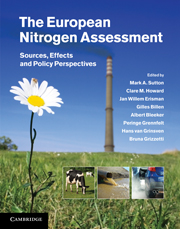Book contents
- Frontmatter
- Contents
- List of contributors
- Foreword
- Summary for policy makers
- Technical summary
- 1 Assessing our nitrogen inheritance
- Part I Nitrogen in Europe: the present position
- Part II Nitrogen processing in the biosphere
- Part III Nitrogen flows and fate at multiple spatial scales
- 10 Nitrogen flows in farming systems across Europe
- 11 Nitrogen flows and fate in rural landscapes
- 12 Nitrogen flows and fate in urban landscapes
- 13 Nitrogen flows from European regional watersheds to coastal marine waters
- 14 Atmospheric transport and deposition of reactive nitrogen in Europe
- 15 Geographical variation in terrestrial nitrogen budgets across Europe
- 16 Integrating nitrogen fluxes at the European scale
- Part IV Managing nitrogen in relation to key societal threats
- Part V European nitrogen policies and future challenges
- Glossary
- Index
- References
13 - Nitrogen flows from European regional watersheds to coastal marine waters
from Part III - Nitrogen flows and fate at multiple spatial scales
Published online by Cambridge University Press: 16 May 2011
- Frontmatter
- Contents
- List of contributors
- Foreword
- Summary for policy makers
- Technical summary
- 1 Assessing our nitrogen inheritance
- Part I Nitrogen in Europe: the present position
- Part II Nitrogen processing in the biosphere
- Part III Nitrogen flows and fate at multiple spatial scales
- 10 Nitrogen flows in farming systems across Europe
- 11 Nitrogen flows and fate in rural landscapes
- 12 Nitrogen flows and fate in urban landscapes
- 13 Nitrogen flows from European regional watersheds to coastal marine waters
- 14 Atmospheric transport and deposition of reactive nitrogen in Europe
- 15 Geographical variation in terrestrial nitrogen budgets across Europe
- 16 Integrating nitrogen fluxes at the European scale
- Part IV Managing nitrogen in relation to key societal threats
- Part V European nitrogen policies and future challenges
- Glossary
- Index
- References
Summary
Executive summary
Nature of the problem
Most regional watersheds in Europe constitute managed human territories importing large amounts of new reactive nitrogen.
As a consequence, groundwater, surface freshwater and coastal seawater are undergoing severe nitrogen contamination and/or eutrophication problems.
Approaches
A comprehensive evaluation of net anthropogenic inputs of reactive nitrogen (NANI) through atmospheric deposition, crop N fixation, fertiliser use and import of food and feed has been carried out for all European watersheds. A database on N, P and Si fluxes delivered at the basin outlets has been assembled.
A number of modelling approaches based on either statistical regression analysis or mechanistic description of the processes involved in nitrogen transfer and transformations have been developed for relating N inputs to watersheds to outputs into coastal marine ecosystems.
Key findings/state of knowledge
Throughout Europe, NANI represents 3700 kgN/km²/yr (range, 0–8400 depending on the watershed), i.e. five times the background rate of natural N2 fixation.
A mean of approximately 78% of NANI does not reach the basin outlet, but instead is stored (in soils, sediments or ground water) or eliminated to the atmosphere as reactive N forms or as N2.
N delivery to the European marine coastal zone totals 810 kgN/km²/yr (range, 200–4000 depending on the watershed), about four times the natural background. In areas of limited availability of silica, these inputs cause harmful algal blooms.
- Type
- Chapter
- Information
- The European Nitrogen AssessmentSources, Effects and Policy Perspectives, pp. 271 - 297Publisher: Cambridge University PressPrint publication year: 2011
References
- 44
- Cited by



